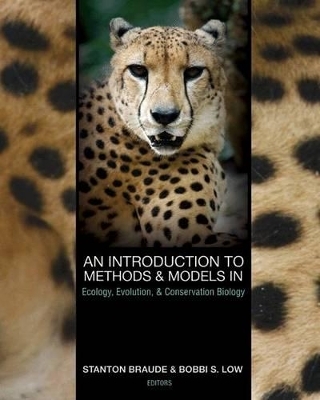
An Introduction to Methods and Models in Ecology, Evolution, and Conservation Biology
Princeton University Press (Verlag)
978-0-691-12724-8 (ISBN)
This unique textbook introduces undergraduate students to quantitative models and methods in ecology, behavioral ecology, evolutionary biology, and conservation. It explores the core concepts shared by these related fields using tools and practical skills such as experimental design, generating phylogenies, basic statistical inference, and persuasive grant writing. And contributors use examples from their own cutting-edge research, providing diverse views to engage students and broaden their understanding. This is the only textbook on the subject featuring a collaborative "active learning" approach that emphasizes hands-on learning. Every chapter has exercises that enable students to work directly with the material at their own pace and in small groups. Each problem includes data presented in a rich array of formats, which students use to answer questions that illustrate patterns, principles, and methods. Topics range from Hardy-Weinberg equilibrium and population effective size to optimal foraging and indices of biodiversity. The book also includes a comprehensive glossary.
In addition to the editors, the contributors are James Beck, Cawas Behram Engineer, John Gaskin, Luke Harmon, Jon Hess, Jason Kolbe, Kenneth H. Kozak, Robert J. Robertson, Emily Silverman, Beth Sparks-Jackson, and Anton Weisstein. * Provides experience with hypothesis testing, experimental design, and scientific reasoning * Covers core quantitative models and methods in ecology, behavioral ecology, evolutionary biology, and conservation * Turns "discussion sections" into "thinking labs" Professors: A supplementary Instructor's Manual is available for this book. It is restricted to teachers using the text in courses. For information on how to obtain a copy, refer to: http://press.princeton.edu/class_use/solutions.html
Stanton Braude is lecturer in biology at Washington University in St. Louis. Bobbi S. Low is professor of resource ecology at the University of Michigan.
Figures vii Tables xi Preface xv Acknowledgments xvii Introduction xix Section I: E volutionary Biology Chapter 1: Evolution and Pesticide Resistance: Examining Quantitative Trends Visually by Stanton Braude and John Gaskin 3 Chapter 2: Lizard Ecomorphology: Generating and Testing Hypotheses of Adaptation by Kenneth H. Kozak 12 Chapter 3: Phylogenetic Inference: Examining Morphological and Molecular Datasets by James Beck 22 Chapter 4: Life History Tradeoffs in Avian Clutch Size: Interpreting Life History Data and Evaluating Alternative Hypotheses by Jon Hess 36 Chapter 5: Mimicry: Experimental Design and Scientific Logic by James Robertson 51 Section II: D emography and Population Ecology Chapter 6: Life Table Analysis by Stanton Braude 63 Chapter 7: Lotka-Volterra Competition Modeling by Stanton Braude, Tara Scherer, and Rebecca McGaha 69 Chapter 8: Explosive Population Growth and Invasive Exotic Species by Jon Hess and James Robertson 79 Chapter 9: Island Biogeography: Evaluating Correlational Data and Testing Alternative Hypotheses by James Robertson 91 Section III: Population Genetics Chapter 10: Hardy-Weinberg: Evaluating Disequilibrium Forces by Jason J. Kolbe 107 Chapter 11: Drift, Demographic Stochasticity, and Extinction in Woggles by James Robertson, Anton Weisstein, and Stanton Braude 117 Chapter 12: Conservation of Small Populations: Effective Population Sizes, Inbreeding, and the 50/500 Rule by Luke J. Harmon and Stanton Braude 125 Chapter 13: Dispersal and Metapopulation Structure by James Robertson 139 Section IV: Quantitative Ecological Tools Chapter 14: Understanding Descriptive Statistics by Beth Sparks-Jackson and Emily Silverman 155 Chapter 15: Understanding Statistical Inference by Emily Silverman and Beth Sparks-Jackson 179 Chapter 16: Sampling Wild Populations by Stanton Braude and James Robertson 189 Chapter 17: Quantifying Biodiversity by Cawas Behram Engineer and Stanton Braude 198 Chapter 18: Environmental Predictability and Life History by Bobbi S. Low and Stanton Braude 214 Chapter 19: Modeling Optimal Foraging by Stanton Braude and James Robertson 226 Section V: S ynthetic Exercises and Writing Assignments Chapter 20: Evaluating Competing Hypotheses of Regional Biodiversity by Stanton Braude 235 Chapter 21: Preparing and Evaluating Competitive Grant Proposals for Conservation Funding by Stanton Braude 239 Chapter 22: Tracing the History of Scientific Ideas: From Darwin, Connell, or Soule to the Present by Bobbi S. Low 245 Glossary 251 Contributors 263 Index 265
| Erscheint lt. Verlag | 24.1.2010 |
|---|---|
| Zusatzinfo | 72 halftones. 12 line illus. 80 tables. |
| Verlagsort | New Jersey |
| Sprache | englisch |
| Maße | 203 x 254 mm |
| Gewicht | 680 g |
| Themenwelt | Naturwissenschaften ► Biologie ► Evolution |
| Naturwissenschaften ► Biologie ► Ökologie / Naturschutz | |
| ISBN-10 | 0-691-12724-7 / 0691127247 |
| ISBN-13 | 978-0-691-12724-8 / 9780691127248 |
| Zustand | Neuware |
| Haben Sie eine Frage zum Produkt? |
aus dem Bereich


